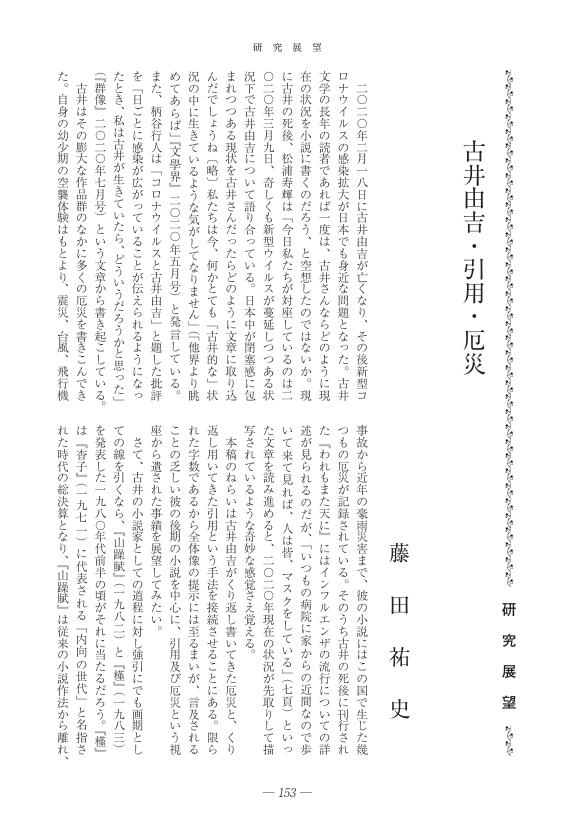9 0 0 0 IR 「芭蕉」使用の分水嶺 : 横溝正史『獄門島』論
- 著者
- 藤田 祐史 FUJITA YUJI
- 出版者
- 名古屋大学大学院人文学研究科図書・編集委員会
- 雑誌
- 名古屋大学人文学フォーラム (ISSN:24332321)
- 巻号頁・発行日
- vol.1, pp.107-120, 2018-03-31
This article examines how to use three Haikus in "Gokumon-tou(Gokumon Island)", one of Yokomizo Seishi's mystery novels. In this mystery, a detective, Kindaichi Kosuke finds the truth of the serial murders. In those cases, each of the victims are compared to Haiku. For example, Yukie, she is the middle of three sisters, is compared to Basho's Haiku "Muzan yana Kabuto no Shita no Kirigirisu (How pitiful! Under a soldier's empty helmet, a cricket sings)". Specifically, Yukie is compared to an old cricket related to white color because Basho's cricket is compared to an old soldier. Then, a big temple bell is compared to a soldier's helmet. What is this criminal doing? The criminal rediscovers the beauty of Haiku. In other words, the criminal plays with Mitate. As I have explained, Mitate is a kind of comparison, and in this paper I solve three mysteries with Kindaichi, and clarify the motive for crime. As a whole, this thesis offers a close reading "Gokumon-tou" focusing on three Haikus and the role of characters. In addition, I show the position of "Gokomon-tou" in the Japanese mystery or Japanese modern literature containing Haiku. "Gokomon-tou" is groundbreaking in these special tricks using Haiku. After this novel we find a lot of mystery writers using Haiku. Especially, Matsumoto Seicho utilize Haiku as a trick or the key to solving the mystery. Seicho knows the characteristics of modern Haiku in comparison with Seishi. He use the characteristics, namely Shasei(sketching)theory, going to famous sightseeing spots, literary coterie magazines, Haiku gathering and so on, in his novels. Then, Yokomitsu Riichi who is a contemporary of Seishi connects Basho's Haiku and Japanese fate. In contract, Seishi's Basho is released from the oppression. Seishi makes free use of Basho's Haiku, and accordingly "Gokumon-tou" becomes a watershed of Basho's Haiku for use in novels.
3 0 0 0 IR 「芭蕉」を使用する : 近現代小説と古井由吉の試み
1 0 0 0 OA 古井由吉・引用・厄災
- 著者
- 藤田 祐史
- 出版者
- 昭和文学会
- 雑誌
- 昭和文学研究 (ISSN:03883884)
- 巻号頁・発行日
- vol.82, pp.153-155, 2021 (Released:2021-10-07)
1 0 0 0 OA 「芭蕉」使用の分水嶺 : 横溝正史『獄門島』論
- 著者
- 藤田 祐史 FUJITA YUJI
- 出版者
- 名古屋大学大学院人文学研究科図書・論集委員会
- 雑誌
- 名古屋大学人文学フォーラム (ISSN:24332321)
- 巻号頁・発行日
- vol.1, pp.107-120, 2018-03-31
This article examines how to use three Haikus in “Gokumon-tou(Gokumon Island)”, one of Yokomizo Seishi’s mystery novels. In this mystery, a detective, Kindaichi Kosuke finds the truth of the serial murders. In those cases, each of the victims are compared to Haiku. For example, Yukie, she is the middle of three sisters, is compared to Basho’s Haiku “Muzan yana Kabuto no Shita no Kirigirisu (How pitiful! Under a soldier’s empty helmet, a cricket sings)”. Specifically, Yukie is compared to an old cricket related to white color because Basho’s cricket is compared to an old soldier. Then, a big temple bell is compared to a soldier’s helmet. What is this criminal doing? The criminal rediscovers the beauty of Haiku. In other words, the criminal plays with Mitate. As I have explained, Mitate is a kind of comparison, and in this paper I solve three mysteries with Kindaichi, and clarify the motive for crime. As a whole, this thesis offers a close reading “Gokumon-tou” focusing on three Haikus and the role of characters. In addition, I show the position of “Gokomon-tou” in the Japanese mystery or Japanese modern literature containing Haiku. “Gokomon-tou” is groundbreaking in these special tricks using Haiku. After this novel we find a lot of mystery writers using Haiku. Especially, Matsumoto Seicho utilize Haiku as a trick or the key to solving the mystery. Seicho knows the characteristics of modern Haiku in comparison with Seishi. He use the characteristics, namely Shasei(sketching)theory, going to famous sightseeing spots, literary coterie magazines, Haiku gathering and so on, in his novels. Then, Yokomitsu Riichi who is a contemporary of Seishi connects Basho’s Haiku and Japanese fate. In contract, Seishi’s Basho is released from the oppression. Seishi makes free use of Basho’s Haiku, and accordingly “Gokumon-tou” becomes a watershed of Basho’s Haiku for use in novels.
1 0 0 0 IR 川端康成『伊豆の踊子』から松本清張『天城越え』へ
- 著者
- 藤田 祐史 FUJITA Yuji
- 出版者
- 名古屋大学人文学研究科
- 雑誌
- 名古屋大学人文学研究論集 (ISSN:2433233X)
- 巻号頁・発行日
- no.2, pp.247-259, 2019-03-31
This paper analyzes Kawabata Yasunari's 1926 novel, The Izu Dancer ("Izu no Odoriko") and Matsumoto Seicho's 1959 novel, Beyond Amagi ("Amagi-goe"). Previous studies discussed the relations between two novels with a focus on the author. In contrast, I examine how "Amagi-goe"is created by imaginative powers of mystery novels. Firstly, I look at the problem from the relevant movie. It raises an issue that "Amagi-goe" is created by previous work. Secondly, I investigate which elements of the "Izu no Odoriko" are translated into the mystery novels. In this paper, I regard "Izu no Odoriko" as resources of detective stories, and research how to use resources. In fact, "Izu no Odoriko" has been used as resources of detective stories, movies, tourism, educations, and so on. "Amagi-goe" is composed of not only an imagination of an author but also plural elements. Thirdly, I place "Izu no Odoriko" or "Amagi-goe" in another context, "From Modern Japanese Literature to mystery novel". In conclusion, it is revealed that "Izu no Odoriko obscured the tragic dancing girl, and "Amagi-goe" or other mystery novels bring to unknown issues.
